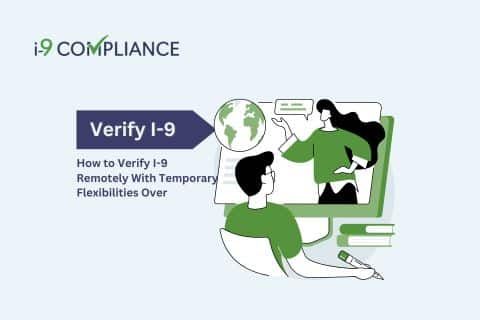How to Verify I-9 Remotely With Temporary Flexibilities Over

August 18, 2023
The deadline for the temporary flexibilities for remotely verifying employment eligibility has passed. As such, the Department of Homeland Security (DHS) has launched new Form I-9 forms and introduced permanent means for remote verification. Employers may now choose whether to verify their employees’ work authorization in person or remotely, depending on whether they qualify for the latter.
Initially, many employers scrambled to adjust their employees to remote positions early in the pandemic. To assist with the transitions, U.S. Immigrations and Customs Enforcement (ICE) and its parent agency, the DHS, offered a temporary alternative. They paused the requirement for verifying identity and work authorization documentation in person. As such, employers could forgo the Form I-9 requirements until a later date.
Under this temporary policy, employers could remotely verify their new hires’ documentation and permit them to continue working. However, employers would have to revisit Form I-9 and physically verify the documentation when the flexibilities ended. This requirement also applies to employees returning to the workplace regularly or predictably before the end date.
Because the public health emergency caused by COVID-19 ended in May 2023, ICE announced the temporary flexibilities would, too. ICE explained that the pandemic-related flexibilities would end on July 31, 2023, and employers would have until August 30, 2023, to adjust accordingly. Employers must use this grace period to physically inspect the original documents provided by employees who used the remote flexibilities.
However, the DHS intervened as the temporary flexibilities came to an end. As employers scrambled to inspect the remotely verified documentation, the DHS introduced the highly anticipated flexibilities for remotely completing the I-9 process.
Furthermore, only qualified employers, such as those registered in the E-Verify system, may use remote flexibilities. Employers that registered and used the system during the flexibility period qualify for remote inspections. An example of remote verifications includes reviews through live video.
Employers must indicate on their employees’ I-9 forms that they used an alternative verification process. The most recent Form I-9 provides a check box in the additional information field to indicate this method. Otherwise, employers using the previous version must write “Alternative procedure” in the additional information field. They must also note the date of the live video interaction. The reviewer must include their initials and the date beneath any annotations entered during the original review.
Completing the I-9 process has proven complicated, regardless of whether employers process them in person. The best way to ensure correctly filled out forms is using an electronic I-9 management system with E-Verify integration. This system guides employers through the entire process, stores the documents, and sends alerts when action is needed to maintain compliance.
Increase your hiring and verification efficiency today with I-9 Compliance automation.